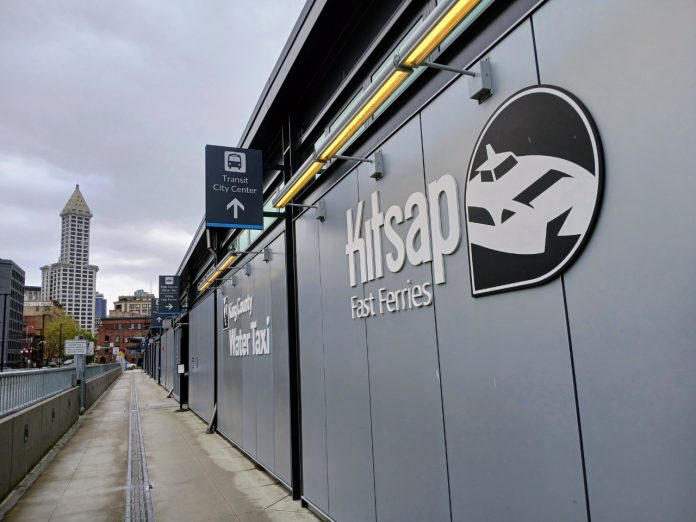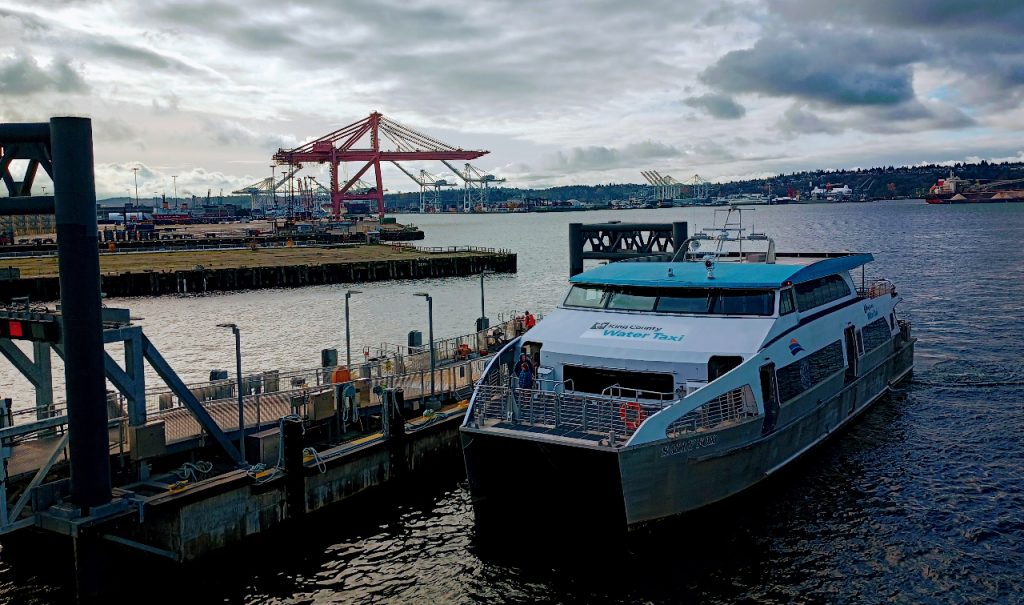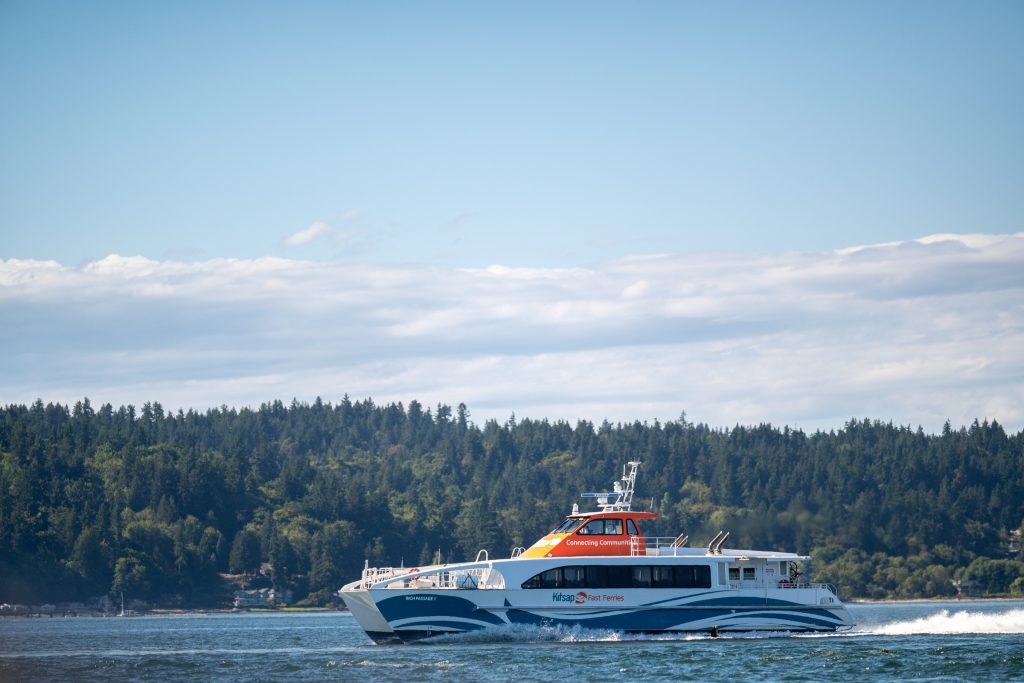
Dozens of Water Taxi and Kitsap Fast Ferry trips would be slashed if the state Senate’s budget writers get their way.
As the Washington State House and Senate work toward a compromise two-year transportation budget ahead of the final day of the legislative session on April 27, the future of a key mobility option for many Puget Sound residents is fully up in the air.
State financial support enables supplemental service on both the King County Water Taxi’s Vashon Island route and Kitsap Transit’s Bremerton fast ferry, a direct response to reduced Washington State Ferries (WSF) service in those areas. While the transportation budget approved by the House early this month includes funding to continue that supplemental service, the state Senate’s budget does not.
Without those dollars, four daily round trips every weekday between Vashon Island and Downtown Seattle would likely be cancelled, along with seven weekday round trips between Bremerton and Downtown Seattle — and all Bremerton fast ferry trips on Saturdays outside of the peak summer season.
The justification behind the Senate’s move is the planned restoration of pre-pandemic ferry service across the state’s domestic routes by this summer. Those service increases will return a third boat to the Vashon-Fauntleroy-Southworth route and a second boat to the Seattle-Bremerton route. Governor Bob Ferguson announced the move earlier this year, to be accomplished by postponing planned electrification work on the state ferry fleet that would have reduced vessel availability. Those car-ladened ferries are significantly slower than passenger fast ferries, however.

The Senate’s transportation budget, which includes a plan to raise $10.2 billion in new revenue over the next six years, would actually increase costs on transit agencies like King County Metro and Kitsap Transit by forcing them to pay a new vehicle registration fee and to pay for the use of state toll facilities, after being exempted for decades. But the $6.3 million to keep the supplemental passenger ferry service running didn’t make the cut.
“It was always intended to sort of be a stop gap until we got the service back up to the standard,” Senate Transportation Committee Chair Marko Liias (D-21st, Edmonds) said at a press conference in early March. “This budget is really focused on making sure that our mainstay Washington State ferry service is healthy and strong and sustainable, that we’re investing in the crew, that we’re investing in the vessels.”
The Senate budget does include funding to provide additional passenger ferry service for two months during the FIFA Men’s World Cup in 2026, a clear nod to the utility of the service overall, but otherwise the additional trips would sunset later this year.
Not everyone is down with going back to a bare-bones passenger ferry network, as evidenced by the House budget. One of the biggest advocates for retaining that funding is Representative Greg Nance (D-23, Bainbridge Island). Earlier this year Nance introduced the Mosquito Fleet Act, which would have expanded the number of local jurisdictions that are able to create passenger ferry districts in the hope of creating new routes. That bill didn’t make it across the finish line and failed to receive a vote in the Senate transportation committee, even after a state-funded grant program to directly fund service was stripped out.
Nance told The Urbanist that the supplemental service actually proved to be a great proof-of-concept, illustrating the benefit of increased foot ferry service.
“What we learned from that is, in the course of backfilling, people realize, wow, actually it’s faster, it’s more efficient, and I can just take my bike, I don’t even need to drive,” Nance told The Urbanist. “And I think it helped thousands of neighbors see themselves as not just a driver and commuting by car, but actually realizing, hey, I can walk or bus or bike, and that is a powerful, powerful place to be as a transit rider.”

At a hearing on the proposed budget in late March, the Senate’s transportation committee heard from advocates for retaining King County’s additional trips to Vashon Island, which were only funded by the state a year ago after advocacy from local lawmakers including Senator (then Representative) Emily Alvarado (D-34th, West Seattle) and King County Councilmember Teresa Mosqueda. While the state ferry takes riders to Fauntleroy terminal in West Seattle, the additional water taxi trips provide riders with a 22-minute trip directly to Downtown Seattle.
“The King County Water Taxi has made up for some of WSF’s shortcomings. They run on schedule. They are mechanically dependable. They can move a lot of people quickly,” Beth Lindsay, a Vashon resident and a member of the Islanders for Ferry Action steering committee, said. “They keep people out of their cars, and they’re affordable. Islanders use the water taxi to get to medical appointments, to commute to work, for social engagements and to connect to cultural events at a time when we need it most.”
The state-funded supplemental service has been a big driver behind increased ferry ridership. Usage of the Seattle-Bremerton fast ferry in 2024 was up 68% over 2022, and the Vashon Island route saw a 55% increase in the last six months of 2024 after trips were added. Walk-on passengers are voting with their feet, as ridership has plummeted on Washington State Ferries, especially routes with competing fast ferries.
Nance, who is hopeful that his Mosquito Fleet Act can return next year to pave the way for other high-potential routes like Everett-Whidbey Island and Bellingham-Friday Harbor, sees the passenger ferries as the type of fiscally responsible investment that the state is going to need to get behind, not shirk away from. He wants the Senate to restore the funding, but is clearly looking beyond that at the potential ability for passenger ferries to be a broader solution. Local port districts like the Port of Olympia have already expressed interest in working on the issue, but don’t yet have the authority from Olympia.
“It also is demonstrating to us that with much, much lower capital and operational outlay, the state can help people get around,” Nance said. “Here is a place I think is really case-in-point where we can [be] delivering a great service, building strong multimodal connections without the full sticker price, [and] we can actually find a pretty dramatic discount, especially in partnership with local ports, which have junior taxing authority, and many of whom are relatively well capitalized.”
Just a week remains in regular session for the two chambers to sort out their competing transportation budgets, and the eventual outcome will make a big difference for passenger ferry riders.
Ryan Packer has been writing for The Urbanist since 2015, and currently reports full-time as Contributing Editor. Their beats are transportation, land use, public space, traffic safety, and obscure community meetings. Packer has also reported for other regional outlets including Capitol Hill Seattle, BikePortland, Seattle Met, and PubliCola. They live in the Capitol Hill neighborhood of Seattle.


